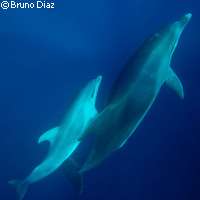Scientists reveal dolphins' diplomatic social behaviour

Scientists from the Bottlenose Dolphin Research Institute (BDRI) on the island of Sardinia off the coast of Italy have published the most complete repertoire ever of sounds made by bottlenose dolphins (Tursiops truncatus). The study shows how the mammals use whistles and burst-pulsed sounds to communicate and maintain their position in their community's social hierarchy. The research results appear in the book Dolphins: Anatomy, Behaviour and Threats by Nova Science Publishers.
Bottlenose dolphins are an extremely vocal mammalian species, but until now scientists believed whistles were the main sounds made by them. They were also largely unaware of the importance and use of burst-pulsed sounds. This latest long-term study, which is based on acoustic recordings and behavioural observations from the surface and underwater off the coast of Sardinia, reveals how both sets of sounds are vital to the social life of these marine mammals.
Spanish scientist Bruno Díaz, lead author of the study and a researcher at the BDRI, along with co-author Paraguayan scientist J. Andrea Bernal Shirai, found that the Sardinian common bottlenose dolphin, like other dolphin populations, has a vocal repertoire consisting 'of 14 audibly distinct social signals that differ from each other in their acoustical structure and duration'. The scientists noted that the creature's 'communication sounds ranged from soft and melodic sounds to harder, almost harsh sounds, with wildly differing durations ranging from the most diminutive twitters to the long and most extravagant screeches and yelps'.
Dr Díaz said this vast range of sounds indicated a complex vocal repertoire in which the tonal whistle sounds - those which are most melodious - are used by dolphins, in particular mothers and their offspring, to stay in contact with each other and to coordinate hunting strategies. He pointed out that the study also produced evidence to show that 'stereotyped or signature whistle patterns were used to call calves back to within visual range of the assumed mother'.
Meanwhile, the burst-pulsed sounds, which are more complex and varied than the whistles, are used 'to avoid physical aggression in situations of high excitement, such as when they are competing for the same piece of food, for example,' explained Dr Díaz.
Bottlenose dolphins make longer burst-pulsed sounds when they are hunting and at times of high aggression, and make it possible for each individual to maintain its position in the pod's social hierarchy, he said, adding that the dolphins emit these strident sounds, for example, when in the presence of other individuals moving towards the same prey, forcing the least dominant mammal to quickly move away in order to avoid confrontation.
The researchers found that the vocal emissions increased 'especially in those activities involving excited depredation or socialising, confirming that activity and social signals production were related'. Moreover, 'the fact that a positive relation was observed between group size and the production of social signals, confirms that dolphin vocalisations are used for communicative and social purposes,' they said.
Drs Díaz and Shirai suggested that in one respect at least, the dolphin appears to be rather more sophisticated than human beings. 'The surprising thing about these sounds is that they have a high level of uni-directionality, unlike human sounds,' the Spanish scientist commented. 'One dolphin can send a sound to another that it sees as a competitor, and this one clearly knows it is being addressed.'
More information: Bottlenose Dolphin Research Institute: www.thebdri.com/
Provided by Cordis















